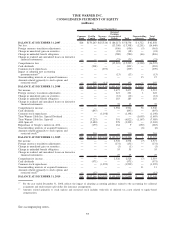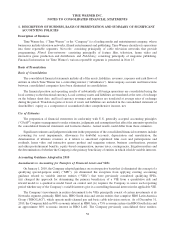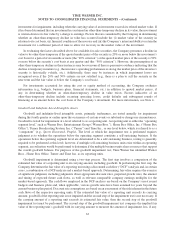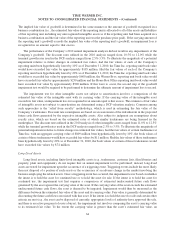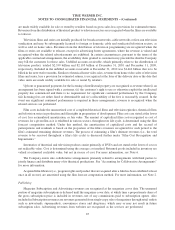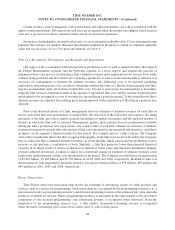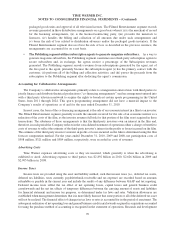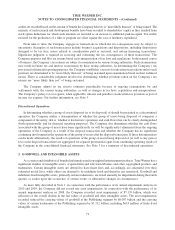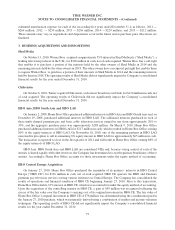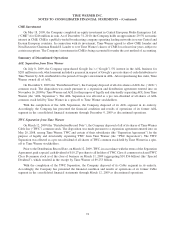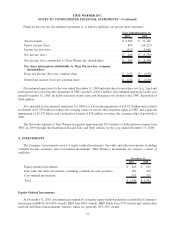Time Magazine 2010 Annual Report Download - page 77
Download and view the complete annual report
Please find page 77 of the 2010 Time Magazine annual report below. You can navigate through the pages in the report by either clicking on the pages listed below, or by using the keyword search tool below to find specific information within the annual report.impairment loss is recognized for the difference. Significant judgments in this area involve determining whether a
triggering event has occurred, determining the future cash flows for the assets involved and selecting the appropriate
discount rate to be applied in determining estimated fair value. For more information, see Note 2.
Accounting for Pension Plans
Time Warner and certain of its subsidiaries have both funded and unfunded defined benefit pension plans, the
substantial majority of which are noncontributory, covering a majority of domestic employees and, to a lesser
extent, have various defined benefit plans, primarily noncontributory, covering international employees. Pension
benefits are based on formulas that reflect the participating employees’ years of service and compensation during
their employment period. Time Warner uses a December 31 measurement date for its plans. The pension expense
recognized by the Company is determined using certain assumptions, including the expected long-term rate of
return on plan assets, the interest factor implied by the discount rate and the rate of compensation increases. In
March 2010, the Company’s Board of Directors approved amendments to its domestic defined benefit plans relating
to eligibility, service credit and future compensation increases. Additional information about the plan amendments
and the determination of pension-related assumptions is discussed in more detail in Note 13.
Equity-Based Compensation
The Company measures the cost of employee services received in exchange for an award of equity instruments
based on the grant-date fair value of the award. That cost is recognized in costs of revenues or selling, general and
administrative expenses depending on the job function of the grantee on a straight-line basis (net of estimated
forfeitures) over the period during which an employee is required to provide services in exchange for the award.
Also, excess tax benefits realized are reported as a financing cash inflow.
The grant-date fair value of a stock option is estimated using the Black-Scholes option-pricing model.Because
the Black-Scholes option-pricing model requires the use of subjective assumptions, changes in these assumptions
can materially affect the fair value of the options. The Company determines the volatility assumption for these stock
options using implied volatilities data from its traded options. The expected term, which represents the period of
time that options granted are expected to be outstanding, is estimated based on the historical exercise experience of
Time Warner employees. Groups of employees that have similar historical exercise behavior are considered
separately for valuation purposes. The risk-free rate assumed in valuing the options is based on the U.S. Treasury
yield curve in effect at the time of grant for the expected term of the option. The Company determines the expected
dividend yield percentage by dividing the expected annual dividend by the market price of Time Warner common
stock at the date of grant. For more information, see Note 12.
Revenues and Costs
Networks
The Networks segment recognizes Subscription revenues as programming services are provided to cable
system operators, satellite distribution services, telephone companies and other distributors (collectively,
“affiliates”) based on negotiated contractual programming rates (or estimated programming rates if a new
contract has not been negotiated) for each affiliate. Management considers factors such as the previous
contractual rates, inflation, current payments by the affiliate and the status of the negotiations in determining
any estimates. When the new distribution contract terms are finalized, an adjustment to Subscription revenue is
recorded, if necessary, to reflect the new terms. Such adjustments historically have not been significant. Advertising
revenues are recognized, net of agency commissions, in the period that the advertisements are aired. If there is a
targeted audience guarantee, revenues are recognized for the actual audience delivery with revenue deferred for any
shortfall until the guaranteed audience delivery is met, typically through the provision of additional air time.
Advertising revenues from websites are recognized as impressions are delivered or the services are performed.
65
TIME WARNER INC.
NOTES TO CONSOLIDATED FINANCIAL STATEMENTS – (Continued)




